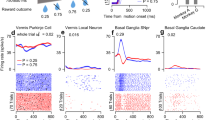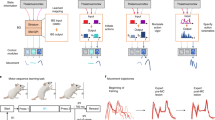Summary
In order to more comprehensively assess the role of the basal ganglia in the internal generation of movements, we studied the activity of neurons in the head of the caudate and in the rostral putamen in relation to the execution of movements. Monkeys performed self-initiated and stimulus-triggered arm reaching movements in separate blocks of trials. With stimulus-triggered movements, 217 striatal neurons increased their activity after the trigger stimulus (127 in caudate, 90 in putamen). Of these, 68 neurons showed time-locked responses to the trigger stimulus, with a median latency of 60 ms, that were independent of visual or auditory stimulus modalities. Three quarters of responses were conditional on a movement being performed. These responses may participate in neuronal processes through which the reception of a stimulus is translated into the execution of a behavioral reaction. Further, 44 neurons increased their activity before the earliest muscle activity without being clearly time-locked to the stimulus (148–324 ms before movement onset), 55 neurons were activated later before the movement, and 50 neurons were activated after movement onset. With self-initiated movements, 106 striatal neurons showed movement-related activity beginning up to 460 ms before movement onset (52 in caudate, 54 in putamen). Comparisons between the two types of movement were made on 53 neurons with premovement activity beginning more than 500 ms before self-initiated movements. Only one fifth of them also showed movement-related activity with stimulus-triggered movements, including trigger responses. Comparisons among 39 neurons with movement-related activity during self-initiated arm movements showed that about half of them also showed movement-related activity with stimulus-triggered movements. These data demonstrate a considerably segregated population of striatal neurons engaged in the internal generation of movements, whereas processes underlying the execution of movements appear to involve overlapping neuronal populations.
Similar content being viewed by others
References
Aldridge JW, Anderson RJ, Murphy JT (1980) The role of the basal ganglia in controlling a movement initiated by a visually presented cue. Brain Res 192: 3–16
Amalric M, Condé H, Dormont JF, Farin D, Schmied A (1984) Activity of caudate neurons in cat performing a reaction time task. Neurosci Lett 49: 253–258
Apicella P, Scarnati E, Schultz W (1991) Tonically discharging neurons of monkey striatum respond to preparatory and rewarding stimuli. Exp Brain Res 84: 672–675
Boch RA, Goldberg ME (1989) Participation of prefrontal neurons in the preparation of visually guided eye movements in the rhesus monkey. J Neurophysiol 61: 1064–1084
Chapman CE, Spidalieri G, Lamarre Y (1984) Discharge properties of area 5 neurons during arm movements triggered by sensory stimuli in the monkey. Brain Res 309: 63–77
Chapman CE, Spidalieri G, Lamarre Y (1986) Activity of dentate neurons during arm movements triggered by visual, auditory, and somesthetic stimuli in the monkey. J Neurophysiol 55: 203–226
Crutcher MD, DeLong MR (1984a) Single cell studies of the primate putamen. I. Functional organization. Exp Brain Res 53: 233–243
Crutcher MD, DeLong MR (1984b) Single cell studies of the primate putamen. II. Relations to direction of movement and pattern of muscular activity. Exp Brain Res 53: 244–258
Davies J, Dray A (1976) Substance P in the substantia nigra. Brain Res 107: 623–627
Evarts EV (1966) Pyramidal tract activity associated with a conditioned hand movement in the monkey. J Neurophysiol 29: 1011–1027
Funahashi S (1983) Responses of monkey prefrontal neurons during a visual tracking task reinforced by substantia innominata self-stimulation. Brain Res 276: 267–276
Georgopoulos AP, DeLong MR, Crutcher MD (1983) Relations between parameters of step-tracking movements and single cell discharge in the globus pallidus and subthalamic nucleus of the behaving monkey. J Neurosci 3: 1586–1598
Gerfen CR (1984) The neostriatal mosaic: compartmentalization of corticostriatal input and striatonigral output systems. Nature 311: 461–464
Godschalk M, Lemon RN, Nijs HGT, Kuypers HGJM (1981) Behaviour of neurones in monkey peri-arcuate and precentral cortex before and during visually guided arm and hand movements. Exp Brain Res 44: 113–116
Graybiel AM, Ragsdale CW, Yoneoka ES, Elde RP (1981) An immunohistological study of enkephalins and other neuropeptides in the striatum of the cat with evidence that the opiate peptides are arranged to form mosaic patterns in register with the striosomal compartments visible by acetylcholinesterase staining. Neuroscience 6: 377–397
Hikosaka O, Sakamoto M, Usui S (1989) Functional properties of monkey caudate neurons. II. Visual and auditory responses. J Neurophysiol 61: 799–813
Ito SI (1982) Prefrontal unit activity of macaque monkeys during auditory and visual reaction time tasks. Brain Res 247: 39–47
Kimura M (1990) Behaviorally contingent property of movement-related activity of the primate putamen. J Neurophysiol 63: 1277–1296
Kimura M, Rajkowski J, Evarts E (1984) Tonically discharging putamen neurons exhibit set-dependent responses. Proc Natl Acad Sci USA 81: 4998–5001
Kojima S (1980) Prefrontal unit activity in the monkey: relation to visual stimuli and movements. Exp Neurol 69: 110–123
Kubota K, Hamada I (1978) Visual tracking and neuron activity in the post-arcuate area in monkeys. J Physiol (Paris) 74: 297–312
Kurata K (1989) Distributions of neurons with set- and movement-related activity before hand and foot movements in the premotor cortex of rhesus monkeys. Exp Brain Res 77: 245–256
Kurata K, Tanji J (1985) Contrasting neuronal activity in supplementary and precentral motor cortex of monkeys. II. Responses to movement triggering vs. nontriggering sensory signals. J Neurophysiol 53: 142–152
Kurata K, Tanji J (1986) Premotor cortex neurons in macaques: activity before distal and proximal forelimb movements. J Neurosci 6: 403–411
Lamarre Y, Busby L, Spidalieri G (1983) Fast ballistic arm movements triggered by visual, auditory and somesthetic stimuli in the monkey. I. Activity of precentral cortical neurons. J Neurophysiol 50: 1343–1358
Liles SL (1985) Activity of neurons in putamen during active and passive movements of the wrist. J Neurophysiol 53: 217–236
Ljungberg T, Apicella P, Schultz W (1992) Responses of monkey dopamine neurons during learning of behavioral reactions. J Neurophysiol 67: 145–163
Mink JW, Thach WT (1991a) Basal ganglia motor control. I. Nonexclusive relation of pallidal discharge to five movement modes. J Neurophysiol 65: 273–300
Mink JW, Thach WT (1991b) Basal ganglia motor control. II. Late pallidal timing relative to movement onset and inconsistent pallidal coding of movement parameters. J Neurophysiol 65: 301–329
Montgomery EB Jr, Buchholz SR (1991) The striatum and motor cortex in motor initiation and execution. Brain Res 549: 222–229
Mroz EA, Brownstein MJ, Leeman SE (1977) Evidence for substance P in the striato-nigral tract. Brain Res 125: 305–311
Nambu A, Yoshida S, Jinnai K (1990) Discharge patterns of pallidal neurons with input from various cortical areas during movement in the monkey. Brain Res 519: 183–191
Niki H (1974) Prefrontal unit activity during delayed alternation in the monkey. I. Relation to direction of response. Brain Res 68: 185–196
Robinson DL, Goldberg ME, Stanton GB (1978) Parietal association cortex in the primate: sensory mechanisms and behavioral modulations. J Neurophysiol 41: 910–932
Rolls ET, Thorpe SJ, Maddison SP (1983) Responses of striatal neurons in the behaving monkey. 1. Head of the caudate nucleus. Behav Brain Res 7: 179–210
Romo R, Schultz W (1987) Neuronal activity preceding self-initiated or externally timed arm movements in area 6 of monkey cortex. Exp Brain Res 67: 656–662
Romo R, Schultz W (1992) Role of primate basal ganglia and frontal cortex in the internal generation of movements. III. Neuronal activity in the supplementary motor area. Exp Brain Res 91: 396–407
Sakai M (1974) Prefrontal unit activity during visually guided lever pressing reaction in the monkey. Brain Res 81: 297–309
Sawaguchi T (1987) Properties of neuronal activity related to a visual reaction time task in the monkey prefrontal cortex. J Neurophysiol 58: 1080–1099
Sawaguchi T, Matsumura M, Kubota K (1989) Depth distribution of neuronal activity related to a visual reaction time task in the monkey prefrontal cortex. J Neurophysiol 61: 435–446
Schultz W (1986) Activity of pars reticulata neurons of monkey substantia nigra in relation to motor, sensory and complex events. J Neurophysiol 55: 660–677
Schultz W (1989) Neurophysiology of basal ganglia. In: Calne DB (ed) Handbook of experimental pharmacology, vol 88, Springer, Berlin, Heidelberg New York, pp 1–45
Schultz W, Romo R (1990) Dopamine neurons of the monkey midbrain: contingencies of responses to stimuli eliciting immediate behavioral reactions. J Neurophysiol 63: 607–624
Schultz and Romo (1992) Role of primate basal ganglia and frontal cortex in the internal generation of movements. I. Preparatory activity in the anterior striatum. Exp Brain Res 91: 363–384
Selemon LD, Goldman-Rakic PS (1985) Longitudinal topography and interdigitation of corticostriatal projections in the rhesus monkey. J Neurosci 5: 776–794
Smith A (1979) The activity of supplementary motor area neurons during a maintained precision grip. Brain Res 172: 315–327
Tanji J, Kurata K (1982) Comparison of movement-related activity in two motor cortical areas of primates. J Neurophysiol 48: 633–653
Thorpe SJ, Rolls ET, Maddison S (1983) The orbitofrontal cortex: neuronal activity in the behaving monkey. Exp Brain Res 49: 93–115
Walker RJ, Kemp JA, Yajima H, Kitagawa K, Woodruff GN (1976) The action of substance P on mesencephalic reticular and substantia nigral neurones of the rat. Experientia 32: 214–215
Watanabe M (1986) Prefrontal unit activity during delayed conditional go/no-go discrimination in the monkey. II. Relation to go and no-go responses. Brain Res 382: 15–27
Weinrich M, Wise S (1982) The premotor cortex of the monkey. J Neurosci 2: 1329–1345
West MO, Carelli RM, Pomerantz M, Cohen SM, Gardner JP, Chapin JK, Woodward DJ (1990) A region in the dorsolateral striatum of the rat exhibiting single-unit correlations with specific locomotor limb movements. J Neurophysiol 64: 1233–1246
Yin TCT, Mountcastle VB (1977) Visual input to the visuo-motor mechanisms of the monkey's parietal lobe. Science 197: 1381–1383
Author information
Authors and Affiliations
Rights and permissions
About this article
Cite this article
Romo, R., Scarnati, E. & Schultz, W. Role of primate basal ganglia and frontal cortex in the internal generation of movements. Exp Brain Res 91, 385–395 (1992). https://doi.org/10.1007/BF00227835
Received:
Accepted:
Issue Date:
DOI: https://doi.org/10.1007/BF00227835




